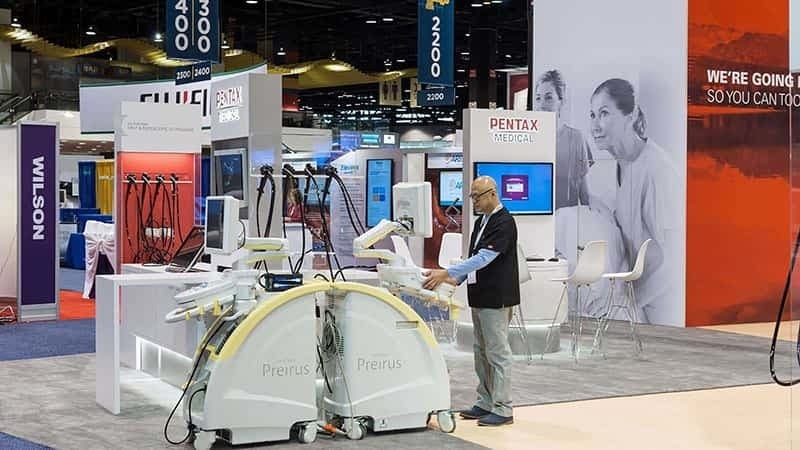Four Ways to Nail a Live Product Demo


Brands can tout the benefits of their products all day long, but simply talking about them doesn’t have much impact on today’s consumers. Place those products in a live setting where the brand can physically demonstrate their value, and it’s a whole different ball game. Before they loosen their purse strings, modern consumers want a tangible experience that allows them to learn about products firsthand. With that in mind, take a look at the following tips for nailing live product demos.
Put the Product in Context
Consumers want to know how a product will personally impact them, so creating live product demos that put the product in context for observers is key. Spireon, for example, which provides cloud-based GPS vehicle tracking software, demonstrates its products in the context of how specific roles at a given company would use and benefit from them.
“In a franchise car dealership, the features of our Kahu product sales associates [use] would be different than those the lot manager [uses] or those in the finance department,” says Carla Fitzgerald, cmo at Spireon. “A sales person would use the mobile app to quickly locate a specific vehicle that a customer is interested in, whereas the lot manager would use the web portal of Kahu to identify the vehicles with low battery life so he can send a lot porter out to start those vehicles. Thus, it’s important [to design] each demo around the correct role and their specific needs.”
Make a Splash
We often think of live product demos as reserved for the trade show floor, but that doesn’t have to be the case. In fact, guerrilla stunts are helping some brands make a big splash while showcasing the benefits of their products without stepping foot in a convention center. Take baby product manufacturer Kolcraft, which erects an adult-sized replica of its Contours Bliss stroller and wheels parents around in it for a stunt that ultimately goes viral. Big enough to carry a 400-pound baby, the oversized stroller’s goal is to give parents a feel for the product’s comfort and features as they chat with a spokesperson. The “test rides” not only turn plenty of heads, but give consumers a tangible sense of the stroller’s benefits (and probably a few laughs along the way). Talk about a live product demos done right!
Find Your Angle
Regardless of the product they’re trying to promote, the majority of brands are likely facing competition in their category. To cut through the noise, marketers need to figure out what differentiates their product, and make it the highlight of their live product demos. Researching the competition’s products to determine where they might be lacking is a good start. And creativity here is key. The more innovative you are about presenting “ordinary” items as extraordinary, the more your brand and products will stand out.
For a stellar example of a brand presenting something that is typically “ordinary” in a fresh, exciting way, look to Google’s Future of the Classroom experience at the 2019 ISTE Annual Conference, where the topic of education becomes anything but ordinary.
Animated icons, quotes, and an interactive map provide a glimpse at how classrooms across the globe are anticipating and reacting to changes in the ways students learn, changes in classroom structure, and shifts in the most valuable subjects.
Users can explore the interconnecting graphics through a linear narrative that emphasizes a geography-based understanding of how educational institutions are changing today.
Make it Hands-on
Giving consumers the opportunity to physically interact with a product is a quick and effective way to familiarize them with its benefits, and tends to be more engaging than watching someone else do it. At Canon’s “Portals” pop-up for its live product demos, the brand put its cameras directly into the hands of consumers to let them experience its features for themselves, offering pointers on shooting techniques along their journey through six different vignettes. A city scene featuring a large puddle, for example, offered attendees a chance to creatively shoot through reflections while experiencing Canon’s flip screen-equipped cameras. And in the pitch-dark Portal of Light vignette, neon light-bar props showed participants how to effectively shoot using the low-light modes offered on Canon cameras. Picture the brand attempting to showcase those same features without letting attendees touch a camera, and you can see why the hands-on approach was essential.
For another prime example of interactive, live product demos done right, look no further than Google Cloud and The New York Times at Google Cloud Next ’19, where the two come together to digitize the Times’ historic archive of photos and clippings. Going further than a traditional product demo, the experience gives new context to and repackages the "product" so users can have a more hands-on experience. On digital drawers that evoke the storage facility for these images that’s lies beneath Times Square, users can view digitized images (all while forming a deeper understanding of the Google Cloud/NY Times partnership). Hotspots on select images unmask hidden connections between these seemingly innocuous images and larger historical and social events. Additionally, smaller drawers within the scenic structure use sensors to trigger brief animations that highlight even more historic images.
Live product demos can take many shapes, but the strategy should always provide a legitimate experience for attendees. Talking at consumers rather than presenting them with something worth talking about will feel more like a direct sales pitch than a product demonstration. You’ve got to give them a show.